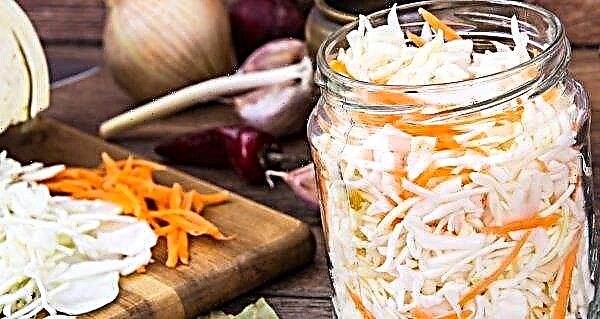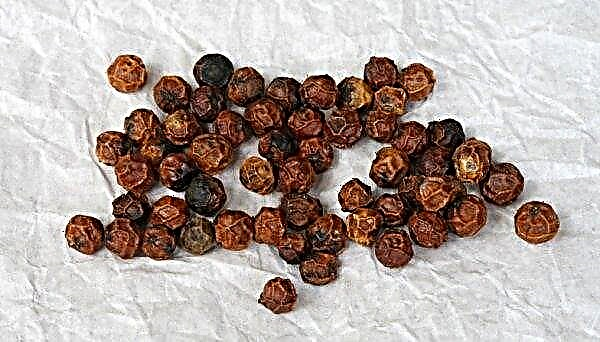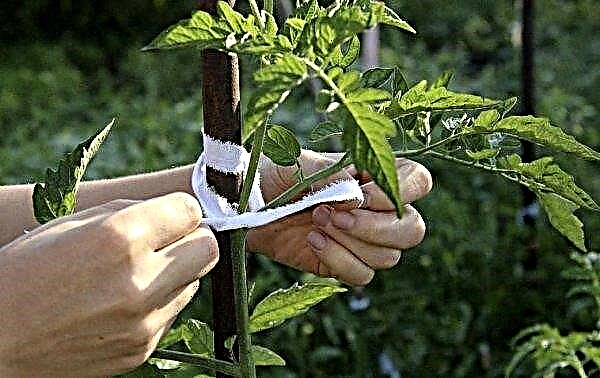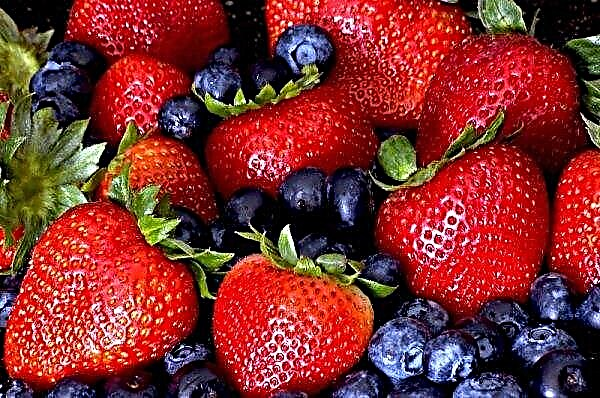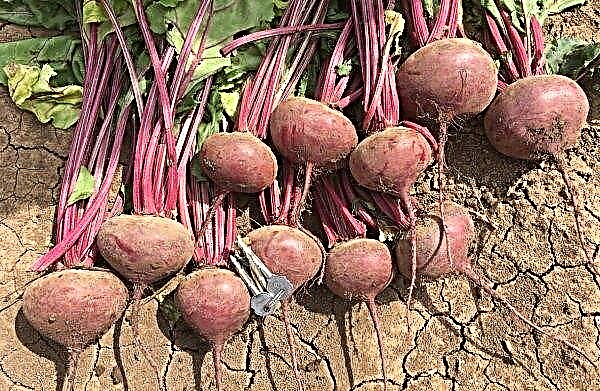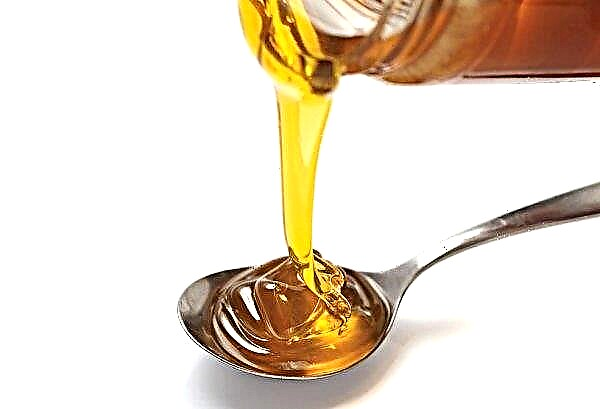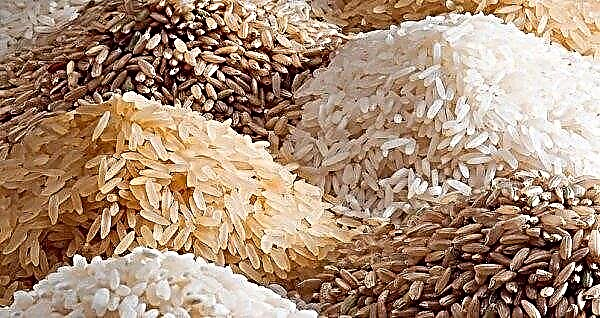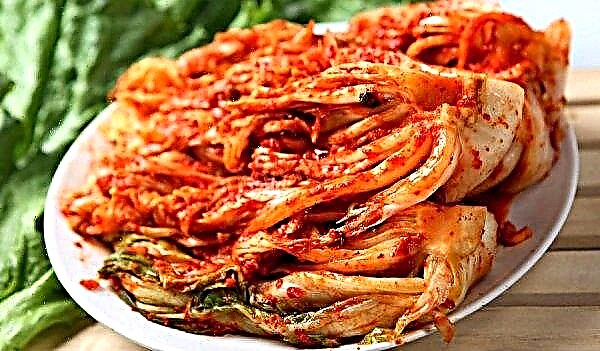One of the most delicious and nutritious types of edible mushrooms is oyster mushroom.. It does not grow on earth, like most other representatives of the kingdom, but in chemical composition is very close to meat and dairy products. The biological description of the fungus, its beneficial properties, the features of growing at home, as well as information about where oyster mushrooms grow, is presented later in the article.
Description and appearance
The Latin name for oyster mushroom is Pleurotus ostreatus, and the people call it an oyster mushroom and a lump. In external characteristics, this mushroom differs from other varieties growing in the forest.
Did you know? Oyster mushroom belongs to predatory fungi - it paralyzes nematodes living in wood with the help of nematotoxin, and then digests them to produce nitrogen.
Botanical description of oyster mushroom:
- The height of the bent cylindrical leg of the fungus does not exceed 3 cm. It is located in the center of the cap or on the side of it and tapers towards the base. The surface of the legs is flat, painted white and gray.
- The smooth hat has a rounded shape, its diameter is 6–30 cm, and its thickness is up to 2 cm. In young specimens, the cap resembles an auricle, but acquires a flat look and wavy edges with age. The color of the hat can range from white to ashen, brown or purple. Its surface is covered with a thin glossy skin with mycelial plaque.
- Oyster mushroom spore powder is colored white or pink, and the spores themselves have a smooth surface and a cylindrical shape.
- On the lower surface of the cap of the fungus are thin plates that begin on the leg. They are rarely located and have the same color as the outer surface of the oyster mushroom apex.
- The pulp is dense, it can be white, grayish or light brown in color. Younger specimens are more juicy, but with age they become fibrous and stiff.
- Oyster mushroom has a pleasant taste, in which there are light anise notes. There is no aroma.
What time of year do they meet
There are many types of oyster mushrooms, which in natural conditions grow from spring to late autumn. But an ordinary oyster mushroom prefers cool weather, so the fruiting season lasts mainly from mid-September to late November. The first oyster mushrooms can appear at the end of May and in the summer, if for a long time there is cold weather, reminiscent of autumn.
Important! Peak fruiting oyster mushroom falls in early October.
How to find which trees and stumps grow on
Like most other types of mushrooms, oyster mushrooms can settle in deciduous and mixed forests located in the temperate zone. These mushrooms are found everywhere in Europe and North America, as well as in Australia, Russia, Egypt, Sudan, India and Pakistan.
But you need to look for them not in the grass, but on the surface of a tree, because the oyster mushroom is a saprophyte, its nutrition is carried out due to the juice of wood. At the same time, science claims that it can be found extremely rarely on conifers.
 Usually oyster mushrooms are found on trunks and are located high above the ground. Mushrooms grow on top of each other in whole colonies, often have one common base and can create a multi-tiered structure on the bark. As a result of their appearance, the wood begins to literally collapse.
Usually oyster mushrooms are found on trunks and are located high above the ground. Mushrooms grow on top of each other in whole colonies, often have one common base and can create a multi-tiered structure on the bark. As a result of their appearance, the wood begins to literally collapse.
Oyster mushrooms grow on deadwood, as well as on stumps, fallen trunks, old and damaged trees:
- Birch tree;
- aspen;
- Linden;
- hornbeam;
- willow;
- oak;
- alder;
- Rowan;
- poplar;
- chestnut;
- Pine.
Growth factors
For successful growth, oyster mushrooms need certain environmental conditions. In nature, the most favorable time for the development of these fungi is the first half of autumn.
 In New Zealand, the cultivation and import of oyster mushrooms is prohibited by law - it is believed that this parasitic mushroom can harm the local flora.
In New Zealand, the cultivation and import of oyster mushrooms is prohibited by law - it is believed that this parasitic mushroom can harm the local flora.
When growing oyster mushrooms in a personal plot, you need to take into account such factors that affect the fruiting of mycelium:
- stable air temperature - active growth of oyster mushrooms occurs at +17 ... + 20 ° С, and some winter varieties can yield crops even at +5 ... + 10 ° С;
- air humidity - It should be about 70% throughout the entire development cycle, i.e. in the drier air the mycelium quickly dries up;
- illumination - oyster mushrooms need sunlight at the stage of formation of fruiting bodies, and the development of mycelium best occurs in the dark;
- substrate quality - mushrooms feed on rotting wood, therefore, grow well on rotten stumps and trunks, and at home for their cultivation you can adapt sawdust, wood chips and straw.
When and how to collect oyster mushrooms
When collecting oyster mushrooms, it is important to correctly determine their degree of maturity. Tearing too young specimens can lose part of the crop, and if you take too much time with this procedure, only old mushrooms will remain. They have a stiffer flesh, so they lose a significant proportion of their pleasant taste.

In order to make the right decision about the seasonal dates for collecting oyster mushrooms, you need to know the main features of this procedure:
- when growing at home, the crop can begin to be harvested 7-10 days after the formation of the embryos of the fruiting body;
- the mushroom sprout is completely broken off - with selective tearing, its common base is damaged, so the small specimens left end their growth;
- it is recommended to take sprouts for 2/3 consisting of mushrooms with a hat diameter of 5-8 cm;
- fruit bodies are carefully removed with your hands - while holding the surface of the substrate and swing the mushrooms in different directions, slightly turning them;
- the broken off oyster mushroom sprout is cleaned of residues of the substrate, cutting them off with a knife;
- during the collection of oyster mushrooms it is recommended to wear a respirator, i.e. spores released during maturation can cause allergies;
- if parts of the base of the fungus remain on the surface of the substrate, they must be carefully removed - otherwise, new oyster mushrooms will not be able to grow in this place.
Important! Oyster mushrooms cannot be separated from the substrate with a knife - at high humidity this can lead to infection of the substrate as a result of decay of the cut site.
Useful properties of mushrooms
When growing oyster mushrooms in ecologically clean regions, fruiting bodies do not accumulate toxins and salts of heavy metals, therefore they have a good taste and useful composition.
 Despite the low calorie content, the product contains a large amount of protein (about 2.5%), vitamins (B, C, E, D and PP), as well as minerals and amino acids necessary for humans.
Despite the low calorie content, the product contains a large amount of protein (about 2.5%), vitamins (B, C, E, D and PP), as well as minerals and amino acids necessary for humans.
- The rich chemical composition determines such useful properties of oyster mushroom dishes:
- lowering blood cholesterol;
- high nutritional value without harm to the figure;
- fast assimilation of the product by the body;
- strengthening immunity;
- prevention of tumor development;
- cleansing the body of toxins;
- normalization of blood pressure;
- prevention of atherosclerosis.
Did you know? In Europe, oyster mushrooms began to be massively consumed during the First World War, using them as an alternative to meat.
Despite the large list of positive qualities, oyster mushroom dishes are not recommended for children under 5 years old., older people and those who have diseases of the gastrointestinal tract, kidneys or liver. This is due to the fact that oyster mushrooms contain chitin, which is poorly absorbed by the human body and is not completely destroyed even after heat treatment.
 Eating oyster mushrooms in food is recommended no more than 2 times a week, because an excessive amount of this product is poorly absorbed by the body and can cause digestive upset.
Eating oyster mushrooms in food is recommended no more than 2 times a week, because an excessive amount of this product is poorly absorbed by the body and can cause digestive upset.
Growing at home
Oyster mushrooms are unpretentious in care and taste like porcini mushrooms, so they are often artificially bred on an industrial scale in the Moscow region and in small households.
To do this, you need to purchase mushroom mycelium in a specialized store, and as a substrate you can use young stumps, decks, straw, sawdust and wood chips. Planting is performed in the spring, choosing a shady place on the site for cultivation.
The oyster mushroom planting algorithm at home is presented below:
- Prepare the substrate (base) by folding its small pieces into a pot of water and boiling them for 1-1.5 hours. If a stump or a deck is used for growing, then they are abundantly treated with boiling water.
- Drain the water, cool the substrate to a temperature of +25 ° C, letting excess water drain. The moisture content of the base before planting should be no more than 30% - this will help prevent the formation of mold.
- Stir the base with mycelium, wearing rubber gloves on your hands. When grown on stumps and decks, planting material is applied in a thin layer to sections and faults of wood.
- Fill clean plastic bags with a mixture of substrate and mycelium. Make side incisions on them - in these places fruiting bodies will form.
- To carry out bags in the closed and dark room with air temperature no more than +25 ° C. Arrange them vertically on the racks so that the walls of the bags do not touch each other. If the landing was carried out on stumps, then they are wrapped with a layer of plastic film with small holes.
- Leave the substrate with mycelium in such conditions for 2.5–3.5 weeks. Wet daily in a room with bags or periodically moisten the surface of a stump wrapped in a film with water planted with mycelium.
- After the emergence of the primordia of mushrooms, transfer the bags to a well-lit place. If mushrooms are planted on stumps, then they remove shelter from the latter.
- Cover the surface of the mycelium with wet gauze, moisturizing it as it dries several times a day. The place where oyster mushrooms are grown should be well ventilated.
 The first portion of the crop is the largest - up to 6 kg of mushrooms can be collected from each bag. New fruiting bodies appear on the site of the collected oyster mushrooms after 2 weeks. The total yield of mushrooms can reach 400 kg / m² per year.
The first portion of the crop is the largest - up to 6 kg of mushrooms can be collected from each bag. New fruiting bodies appear on the site of the collected oyster mushrooms after 2 weeks. The total yield of mushrooms can reach 400 kg / m² per year.
Numerous useful properties and good taste have made oyster mushroom a popular ingredient for preparing various dishes. Using the above information, you can find the answer to the question of where to find this mushroom in the forest, as well as learn how to grow and propagate it yourself on your site, getting a generous and regular crop.

